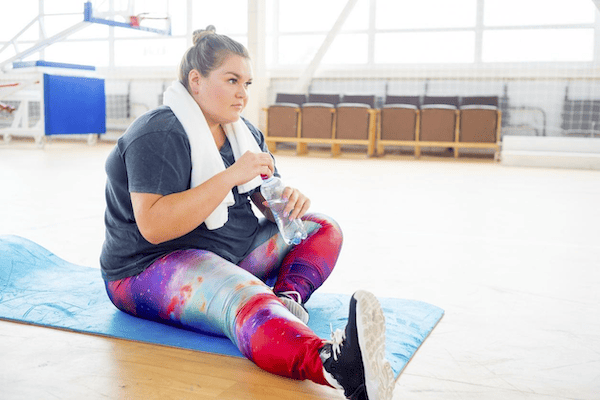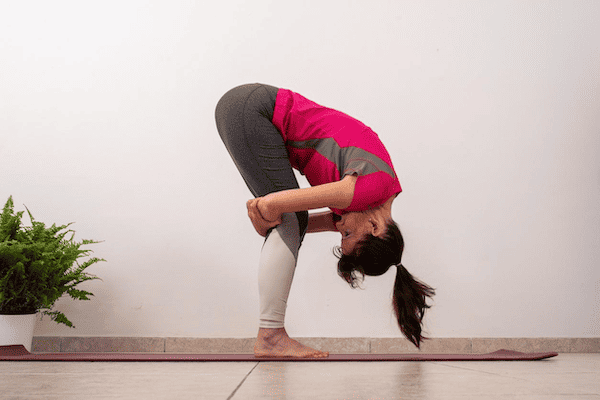
You’re not alone if you’ve tried yoga only to end up feeling sick, asking yourself, “Why does yoga make me nauseous?” Feeling sick after doing yoga is a common phenomenon that I’ve personally seen many people experience during my years as a yoga teacher and yoga therapist. Even flu-like symptoms after yoga are not unheard of.
Before you either give up on yoga or give it another try, take the time to learn about the possible reasons you may be feeling nauseous and what you can do about it. I’m Anna Passalacqua, Co-Founder and Teacher at Breathing Deeply Yoga Therapy. I’m here to share my knowledge about yoga so more people will be able to use it safely and effectively. Keep reading to learn more!
10 Reasons Why Yoga May Make You Nauseous
So, why does yoga make you nauseous? It can vary from person to person, but these are the top 10 most common reasons I’ve encountered.
1. Low Blood Pressure
Blood pressure issues are one of the biggest culprits for feeling sick after doing yoga. Certain movements that are common in yoga, such as putting your head between your legs and then standing back up, can make you feel dizzy and nauseous if you have low blood pressure. Breathing too slowly or quickly can be another source of trouble, along with holding a pose for too long. If you take medication that affects your blood pressure, then practicing yoga could make you feel sick.
2. High Blood Pressure
Studies have shown that there is a correlation between high blood pressure and nausea. For reference, a normal, healthy blood pressure typically means having a systolic pressure between 90 and 119 and a diastolic pressure between 60 and 79. Holding a yoga pose for too long can trigger nausea and vomiting in some people, especially those who already have high blood pressure.
3. Lack of Food
Yoga, especially pranayama (breathing exercises), can stimulate the parasympathetic nervous system, also known as the rest-and-digest response. This causes peristalsis, which means that your stomach juices and acids are activated to help move food through your digestive system. But if you haven’t eaten enough, this can make you feel lightheaded, dizzy, or nauseous.
Lack of food can also be an issue for people with diabetes or other causes of low blood sugar. You could feel lightheaded, dizzy, or nauseous while exercising. When your blood sugar drops too low, it triggers the fight-or-flight response that ramps up your body’s production of adrenaline. This can cause sweating, shakiness, and anxiousness, among other symptoms.
4. Eating Too Soon
While lack of food can cause nausea or flu-like symptoms after yoga, so can eating too soon right before yoga. For this reason, many yoga instructors recommend waiting two hours after eating to practice yoga. That’s a more conservative estimate, as the right amount of time for you will depend on what you eat and your metabolism. Some people will be able to practice yoga just 30 minutes after eating without issue.
5. Overheating
Getting overheated can be another explanation for why yoga makes you nauseous. Hot yoga, a form of yoga performed in hot and often humid conditions, is a prime example. Examples of hot yoga include Bikram Yoga and Power Yoga. These yoga classes are held in rooms ranging from around 80–100° F (27–38° C), and the humidity level is often between 40% and 60%.
This combination of heat and humidity can cause even veteran yoga practitioners to develop flu-like symptoms after yoga, the most common of which include dizziness, muscle or body aches, and nausea. That said, hot yoga is not the only style of yoga known to trigger these adverse reactions. Any yoga practice that challenges or overexerts you and leads you to become overheated can make you feel sick. Ashtanga yoga and Vinyasa Yoga, for example, are more challenging styles where overheating can be an issue.
6. Dehydration

Sweating and not drinking enough fluids while practicing yoga is a surefire way to trigger nausea and other unpleasant symptoms, especially when practicing hot yoga. When this happens, it can lead to nausea or, in more severe cases, vomiting or diarrhea. At the same time, drinking too much water while practicing yoga can also trigger nausea.
7. Too Much Caffeine
According to the Food and Drug Administration (FDA), adults should consume no more than 400 mg of caffeine daily. Anything more than that can negatively affect the body. Along with jitteriness, lightheadedness, and diarrhea, excessive amounts of caffeine can cause nausea. That is especially true when someone engages in physical activity, including yoga.
The combination of being overheated and over-caffeinated can have the same effect. It can also trigger headaches and an irregular heartbeat, both of which further increase the chances of suffering from nausea, vomiting, and other feelings of malaise. Caffeine is also a diuretic, which can cause you to urinate more fluid than you intake, contributing to dehydration.
8. Hormonal Changes
Any hormonal changes can make you more susceptible to nausea, which can leave you feeling sick after doing yoga. Hormonal imbalances are common in middle age, due to low levels of either testosterone or estrogen. Pregnancy and menstruation can also contribute to hormonal changes that make you nauseous from yoga. Even practicing yoga right before or after your period could make you feel unwell.
9. Stress or Anxiety
Stress and anxiety are also common culprits behind nausea. Not only can these mental conditions contribute to your physical symptoms, but they may also be behind certain lifestyle issues that cause you to feel nauseous during yoga.
For instance, if you’re stressed, you might stress eat too soon before practicing yoga. Or your anxiety could curb your appetite and you practice yoga with too little food in your stomach. Maybe you’re too busy dealing with other things, whether it’s work or caregiving for another person, and you end up neglecting your own care and forgetting to eat. The result could be feeling dizzy or sick when you practice yoga.
10. Sensitivity to Certain Poses

Not all yoga poses are right for everyone. Poses that require you to be upside down for long periods can cause dizziness, and ones that involve twists or stomach compressions can cause nausea. Many poses involve compressing your digestive system, which some people may be sensitive to. If you aren’t used to bringing your knees to your chest, for example, it could trigger nausea. Moving too quickly from one yoga pose to another can cause dizziness and even nausea for some people.
What to Do if You’re Feeling Sick After Doing Yoga
If yoga makes you nauseous, there are a number of steps you can take to try to remedy the situation.
Listen to Your Body
First and foremost, everyone should have agency over their own body and what they are feeling. Listen to your body. When you’re in a group yoga class, the instructor’s job is to teach to the whole group, rather than to the individual. It’s important for each person to listen to their own body and know how they’re showing up for that class that day. For instance, recognize if you are coming to yoga stressed, if you’re in the midst of any hormonal changes, or if you feel yourself getting overheated.
Take a Break
If you start feeling hot, dizzy, lightheaded, nauseous, or sick, stop what you’re doing. Take a seat and take a break. Sit upright in a chair or against a wall, keeping your spine in a neutral position and keeping your head above your heart. Sometimes I’ve encountered people, especially in yoga classes, who feel embarrassed to take a break. It’s not a problem, and it’s perfectly normal.
Time Your Meals
Be conscious of when you eat, timing your meals and yoga practice accordingly. Don’t eat too soon beforehand, but don’t skip eating altogether either. If you’ve been feeling sick after doing yoga and think this could be the reason, try eating 2 to 3 hours before you practice yoga.
Stay Hydrated
Drink plenty of water before you practice yoga. You may also want to avoid caffeine to help keep you hydrated.
See a Medical Professional
If you have changed your habits and eliminated other causes such as blood pressure issues and still experience nausea from yoga, see a medical professional to ask, “Why does yoga make me nauseous?” Confirm that you are healthy enough to practice yoga and identify any contraindications you may have, especially if you are on medication, have high or low blood pressure, or have been diagnosed with a medical condition.
Work with a Yoga Therapist

Depending on what you want to accomplish with yoga and whether you are deemed fit to practice yoga by a doctor, you could benefit from working with a yoga therapist. If you want to use yoga to treat a specific physical or mental condition, such as back pain or stress, then yoga therapy can help.
A yoga therapist is trained to work one-on-one with clients, applying yoga techniques to specific health conditions while taking the whole person into account. We can design custom yoga sequences and practices based on your unique needs. Unlike group yoga classes, the techniques we recommend are individualized, and we teach you how to practice them at home yourself after working with us. If you want to continue practicing yoga in a group setting, we can also teach you how to do so safely by avoiding or modifying certain techniques.
Want to learn more? At Breathing Deeply, we’re proud to offer one-on-one yoga therapy sessions online via Zoom. Read about our work and submit a contact form to see if yoga therapy is right for you.


